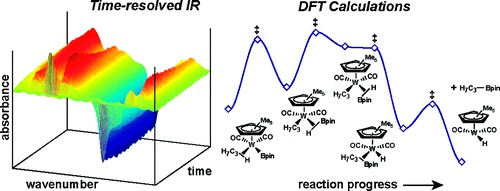Time-resolved IR Studies on the Mechanism for the Functionalization of Primary C−H Bonds by Photoactivated Cp*W(CO)3(Bpin)
J. Am. Chem. Soc., 2010, 132 (1848-1859)
View on publisher site
Abstract
Recently, transition-metal−boryl compounds have been reported that selectively functionalize primary C−H bonds in alkanes in high yield. We have investigated this process with one of the well-defined systems that reacts under photochemical conditions using both density functional theory calculations and pico- through microsecond time-resolved IR spectroscopy. UV irradiation of Cp*W(CO)3(Bpin) (Cp* = C5(CH3)5; pin = 1,2-O2C2-(CH3)4) in neat pentane solution primarily results in dissociation of a single CO ligand and solvation of the metal by a pentane molecule from the bath within 2 ps. The spectroscopic data imply that the resulting complex, cis-Cp*W(CO)2(Bpin)(pentane), undergoes C−H bond activation by a σ-bond metathesis mechanism—in 16 μs, a terminal hydrogen on pentane appears to migrate to the Bpin ligand to form a σ-borane complex, Cp*W(CO)2(H-Bpin)(C5H11). Our data imply that the borane ligand rotates until the boron is directly adjacent to the C5H11 ligand. In this configuration, the B−H σ-bond is broken in favor of a B−C σ-bond, forming Cp*W(CO)2(H)(C5H11-Bpin), a tungsten−hydride complex containing a weakly bound alkylboronate ester. The ester is then eliminated to form Cp*W(CO)2(H) in approximately 170 μs. We also identify two side reactions that limit the total yield of bond activation products and explain the 72% yield previously reported for this complex.
Read on publisher's site